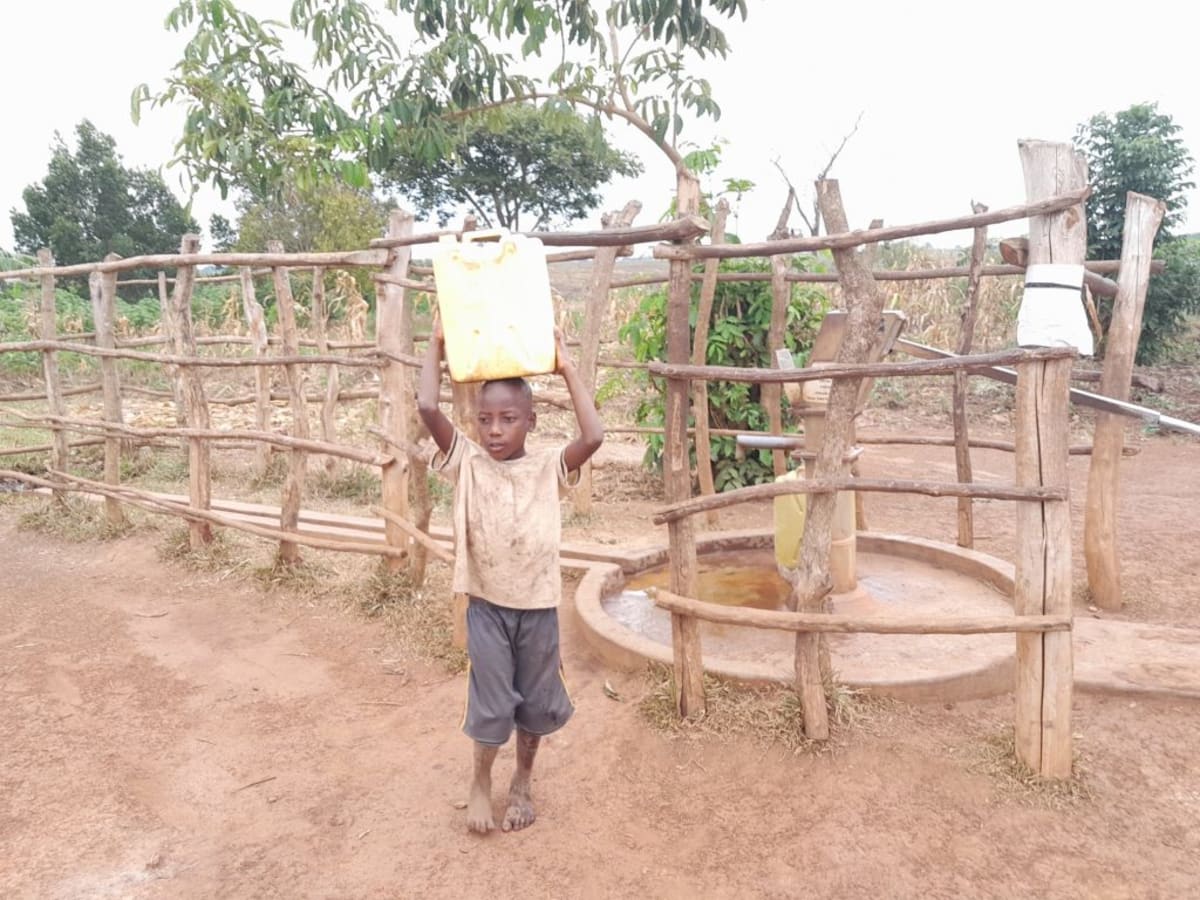Currently, the 325 community members of Bubanda 1 Kyabarongo travel to the next village's borehole well for their water, which is a long distance for even those closest to the border. One trip to fetch water can take two hours or longer for the others who live on the opposite side of their village. Overcrowding is also a significant issue and causes delays.
"I always go to the water point with two jerrycans, but depending on the number [of people] at the well, sometimes I delay and come back late," said Gerald W., who is eight years old.
"My mother questions me, and [I] am always worried of answering her back because sometimes she doesn't understand. The water crisis has really affected me psychologically. [I] am always scared of answering questions from my parents."
When the community members reach the adjacent village's well, the water they collect is clean. But because it takes so long to travel there and wait in lines, people often choose to find water closer to home. Usually, this means they dig scoopholes or purchase water at the local dam (which is frequently occupied by cows) using their scarce finances.

Beatrice Karungi, a local housewife, shared: "Due to the delays I encounter at the water point, my activities are interfered with. This has also affected my children, who end up going to school very late since they have to support me with other daily chores."
Beatrice further explained that her children's academic performance has been highly affected; some even dropped out of school at an early age.
This is a community of farmers, but because they spend so much time in search of water every day, their output is severely limited. This leaves community members, especially children, malnourished. The soil here is fertile and ready for use. The only resources the community members need are time...and safe, reliable water.
Here's what we're going to do about it:
New Borehole
This new borehole is an exciting opportunity for this community! We work with the community to determine the best possible sites for this well.
We conducted a hydrogeological survey and the results indicated the water table is an ideal candidate for a borehole well. Due to a borehole well's unique ability to tap into a safe, year-round water column, it will be poised to serve all of the water needs for this community, even through the dry months.
Community members will help collect the needed construction materials such as sand, rocks, and water for mixing cement. They will also provide housing and meals for the work team, in addition to providing local laborers. We will complement their materials by providing an expert team of artisans and drilling professionals, tools, hardware, and the hand-pump. Once finished, water from the well will then be used by community members for drinking, handwashing, cooking, cleaning, and much more.
Training
Training's main objectives are the use of latrines and observing proper hygiene practices since these goals are inherently connected to the provision of clean water. Open defecation, water storage in unclean containers and the absence of hand-washing are all possible contaminants of a household water supply. Each participating village must achieve Open Defecation Free status (defined by one latrine per household) prior to the pump installation for this borehole well.
This social program includes the assignment of one Community Development Officer (CDO) to each village. The CDO encourages each household to build an ideal homestead that includes: a latrine, a handwashing facility, a separate structure for animals, a rubbish pit and a drying rack for dishes.
We also implement the Community-Led Total Sanitation (CLTS) approach with each of our village partners. This aims to improve the sanitation and hygiene practices and behaviors of a village. During these sessions, village leaders naturally emerge and push the community to realize that the current practices of individual households – particularly the practice of open defecation – are not only unhealthy, but affect the entire village. CLTS facilitates a process in which community members realize the negative consequences of their current water, sanitation and hygiene behaviors and are inspired to take action. Group interactions are frequent motivators for individual households to build latrines, use them, and demand that other households do the same.
Improved Sanitation
The aim is that all households own an improved latrine. Many households do not use a latrine but use the bush. Due to open defecation, feces are spread all over the village. This leads to waterborne diseases and contamination of groundwater and surface water. Our aim is that the community is able to live a healthy life free of preventable diseases. We endeavor that at the end of our presence in the community, people will have both access to sustainable, clean water and access to sanitation. We have now organized families to form digging groups for latrine construction, and empowered them with tools to use.

 Borehole Well and Hand Pump
Borehole Well and Hand Pump
 Rehabilitation Project
Rehabilitation Project


























